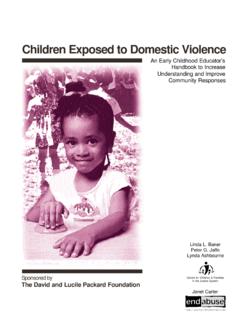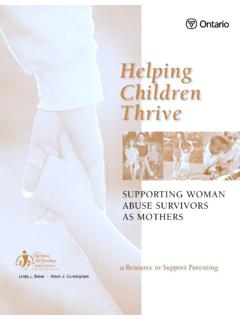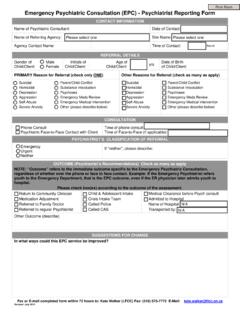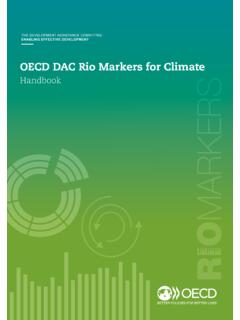Transcription of Maltreatment and the Developing Brain - LFCC
1 Sharing ideas to help children Lecture byBruce D. Perry, , and the Developing Child:How Early Childhood Experience Shapes Child and CultureDr. Perry is an internationally recognized authority on child trauma and the effectsofchild Maltreatment . His work is instrumental in understanding the impact oftraumatic experiences and neglect on the neurobiology of the Developing presented the inaugural Margaret McCain lecture on September 23, 2004We seek to make the world a betterplace. No matter our profession orvocation, we share the desire and theability to make a difference in a child s are complex creatures. Whilehaving the capacity to be humane, wealso have the capacity to be cruel. Why?What determines whether a child growsup to be compassionate, thoughtful, andproductive? Or, impulsive,aggressive, hateful, and non-productive?Is it genetic? Likely not. Human beings become areflection of the world in which theydevelop. If that world is safe, predictable,and characterized by relationally andcognitively enriched opportunities, thechild can grow to be self-regulating,thoughtful, and a productive member of family, community, and society.
2 Incontrast, if the Developing child s world ischaotic, threatening, and devoid of kindwords and supportive relationships, achild may become impulsive, aggressive,inattentive, and have difficulties withrelationships. That child may requirespecial educational services, mental healthoreven criminal justice intervention. The challenge for us is to help eachchild reach his or her potential to behumane. To better understand how, we must appreciate the remarkablemalleability of our species and theunique role played by the human Developing Brain The human Brain mediates ourmovements, our senses, our thinking,feeling and behaving. The amazing,complex neural systems in our Brain ,which determine who we become, areshaped early. In utero and during the first four yearsof life, a child s rapidly Developing brainorganizes to reflect the child senvironment. This is because neurons,neural systems, and the Brain change ina use-dependent way. Physicalconnections between neurons synapticconnections increase and strengthenthrough repetition, or wither throughdisuse.
3 It follows, therefore, that eachbrain adapts uniquely to the unique setof stimuli and experiences of each child sworld. Early life experiences, therefore,determine how genetic potential isexpressed, or the Brain organizes, the lower moreregulatory systems develop first. During the first years of life, the higher parts of the Brain become organized and morefunctionally capable. Brain growth anddevelopment is profoundly front loaded such that by age four, a child s Brain is 90% adult size! This time of greatopportunity is a biological gift. In anurturing environment, a child can growto achieve the full potential pre-ordainedby underlying genetics. We can promotethis by fostering conditions of brainstem controls heart rate, bodytemperature, and other survival-relatedfunctions. It also stores anxiety or arousal statesassociated with a traumatic event. Movingoutward towards the neocortex, complexity offunctions increases.
4 The limbic system storesemotional information and the neocortexcontrols abstract thought and cognitive SERIESO ptimal DevelopmentA child is most likely to reach her fullpotential if she experiences consistent,predictable, enriched, and stimulatinginteractions in a context of attentiveand nurturing relationships. Aided by many relational interactions perhaps with mother, father, sibling,grandparent, neighbour and more young children learn to walk, talk, self-regulate, share, and solve child will face new andchallenging situations. These stress-inducing experiences per se need notbe problematic. Moderate, predictablestress, triggering moderate activation ofthe stress response, helps create acapable and strong stress-responsecapacity, in other words, resilience. Thefirst day of kindergarten, for example, isstressful for children. Those embeddedin a safe and stable home baseovercome the stress of this newsituation, able to embrace thechallenges of Development While most children experience safeandstable upbringings, we know all toowell that many children do not.
5 The very biological gifts that makeearly childhood a time of greatopportunity also make children veryvulnerable to negative experiences:inappropriate or abusive caregiving, alack of nurturing, chaotic andcognitively or relationally impoverishedenvironments, unpredictable stress,persisting fear, and persisting physicalthreat. These adverse effects could beassociated with stressed, inexperienced,ill-informed, pre-occupied or isolatedcaregivers, parental substance abuseand/or alcoholism, social isolation, orfamily violence. Chronic exposure ismore problematic than the most extreme and tragic casesof profound neglect, such as whenchildren are raised by animals, thedamage to the Developing Brain andchild is severe, chronic, and resistantto interventions later in Adaptive Response to Threat When a child is exposed to any threat,his Brain will activate a set of adaptiveresponses designed to help him is a continuum of adaptiveresponses to threat and differentchildren have different adaptive use a hyperarousal response ( ,fight or flight) and some a dissociativeresponse (essentially tuning out theimpending threat).
6 In most traumaticevents, a combination of the two child adopting a hyperarousalresponse may display defiance, easilymisinterpreted as wilful children may be resistant or even aggressive. They are locked in a persistent fight or flight state. They often display hypervigilance,anxiety, panic, or increased heart rate. A hyperarousal response is morecommon in older children, males, and in circumstances where trauma involveswitnessing or playing an active role inthe dissociative response involvesavoidance or psychological flight,withdrawing from the outside worldand focusing on the inner. The intensityof dissociation varies with the intensityof the trauma. Children may bedetached, numb, and have a low heartrate. In extreme cases, they maywithdraw into a fantasy world. Adissociative child is often compliant(even robotic), displays rhythmic self-soothing such as rocking, or may faint iffeeling extreme distress. Dissociation ismore common in young children,females, and during traumatic eventscharacterized by pain or inability State ReactivityA child with a Brain adapted for anenvironment of chaos, unpredictability,threat, and distress is ill-suited to themodern classroom or playground.
7 It isan unfortunate reality that the veryadaptive responses that help the childsurvive and cope in a chaotic andunpredictable environment puts thechild at a disadvantage when outsidethat children experience repetitiveactivation of the stress responsesystems, their baseline state of arousal isaltered. The result is that even whenthere is no external threat or demand,they are physiologically in a state ofalarm, of fight or flight. When astressor arises, perhaps an argumentwith a peer or a demanding school task,they can escalate to a state of fear veryquickly. When faced with a typicalexchange with an adult, perhaps ateacher in a slightly frustrated mood,the child may over-read the non-verbalcues such as eye contact or to their peers, therefore,traumatized children may have lesscapacity to tolerate the normalThese images illustrate the negative impact ofneglect on the Developing Brain . The CT scanon the left is from a healthy three-year-oldwith an average head size.
8 The image on theright is from a three-year-33old child sufferingfrom severe sensory-deprivation neglect. Thischild s Brain is significantly smaller and hasabnormal development of EventProlonged Alarm ReactionAltered NeuralSystemsTHELECTURE SERIES demands and stresses of school, home,and social life. When faced with achallenge, for example, resilient childrenare likely to stay calm. Normal childrenin the same situation may becomevigilant or perhaps slightly children will react with fearor terror. Fear Changes the Way We Think Children in a state of fear retrieveinformation from the world differentlythan children who feel calm. In a state of calm, we use the higher,more complex parts of our Brain toprocess and act on information. In astate of fear, we use the lower, moreprimitive parts of our Brain . As theperceived threat level goes up, the lessthoughtful and the more reactive ourresponses become. Actions in this statemay be governed by emotional andreactive thinking noted above, when childrenexperience repetitive activation of thestress response systems, their baselinestate of arousal is altered.
9 Thetraumatized child lives in an arousedstate, ill-prepared to learn from social,emotional, and other life is living in the minute and may notfully appreciate the consequences ofher actions. Add alcohol to the mix, orother drugs, and the effect is the Alarm StateIt is important to understand that thebrain altered in destructive ways bytrauma and neglect can also be alteredin reparative, healing ways. Exposingthe child, over and over again, todevelopmentally appropriateexperiences is the key. With adequaterepetition, this therapeutic healingprocess will influence those parts of thebrain altered by developmental most of our therapeuticefforts fall short of can also be good role models: inall our interactions with children we canbe attentive, respectful, honest, andcaring. Children will learn that not alladults are inattentive, abusive,unpredictable, or is paramount that we provideenvironments which are relationallyenriched, safe, predictable, andnurturing.
10 Failing this, our conventionaltherapies are doomed to be a child is in a therapeuticrelationship, we can help him betterunderstand the feelings and behavioursthat are the legacy of abuse andneglect. Information helps. Atraumatized child may act impulsivelyand misunderstand why perhapsbelieving she is stupid, bad, selfish ordamaged. We can also teach adults in achild s life about how traumatizedchildren think, feel, and behave. Among the possible therapeuticoptions to help maltreated andtraumatized children are cognitive-behavioural therapy, individual insight-oriented psychotherapy, family therapy,group therapy, play or art therapy, eye-movement desensitization and re-programming (EMDR), andpharmacotherapy. Each of these hassome promising results and manydisappointments. Therapy with maltreated children isdifficult for many reasons. In the longterm, the wisest strategy is to preventabusive, neglectful, and chaoticcaregiving. In that way, fewer childrenwill require and Solutions We are the product of our health and creativity of acommunity is renewed each generationthrough its children.






